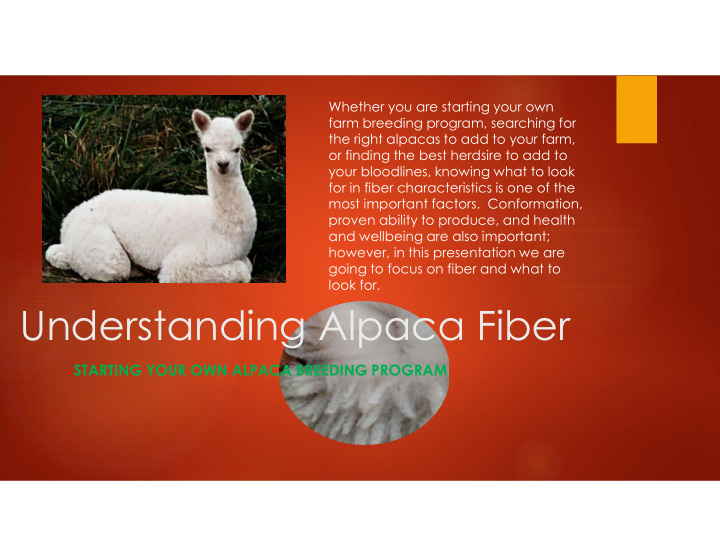



Whether you are starting your own farm breeding program, searching for the right alpacas to add to your farm, or finding the best herdsire to add to your bloodlines, knowing what to look for in fiber characteristics is one of the most important factors. Conformation, proven ability to produce, and health and wellbeing are also important; however, in this presentation we are going to focus on fiber and what to look for. Understanding Alpaca Fiber STARTING YOUR OWN ALPACA BREEDING PROGRAM
When looking at the fleece, you want to see crimp, length and frequency. You want to feel a soft, dense handle. Crimp: Crimp are the ripples or waves in fiber. Fiber with high frequency (waves or crimp per inch) tends to be finer and denser and easier to spin, although there are many styles of crimp that are soft and desirable. Consistency throughout the blanket is important and something to consider. Frequency: Crimp can be described as having a high or low frequency (crimps per inch) or as having high or low amplitude (high waves or low waves) Density: The most reliable way to determine density is through a skin biopsy test; however, when parting the fiber you should see a very thin line of skin. If there is a wide line, most likely this is not a dense fleece. Suri Alpaca fleece: Suri fleece is judged differently than the huacaya fleece we’ve been referring to throughout this article. Suris are rare. When looking at suri alpaca fleece “luster”, shine and brightness are very important: it should feel like silk and have a draping and somewhat locking appearance.
Histograms A histogram is the most objective and efficient way of ascertaining fiber characteristics. Several important pieces of information can be gathered: Mean Fiber Diameter: Fiber diameter is • measured in microns. One micron is equal to one millionth of a meter or 1/25,400th of one inch. Standard Deviation • Coefficient of Variation • Fibers Greater Than 30 microns •
Histograms Mean Fiber Diameter: This is the figure normally quoted in “shear statistics”, referred to as Micron. The lower this number, usually the better. Classification of Microns Royal: <18 • Superfine/Baby: 18 - 20 • Fine: 20 - 24.9 • Medium: 25 - 29.9 • Strong: 30+ • Standard Deviation: The SD measures the uniformity of the fleece. SD reflects the range of micron above and below the mean. Coefficient of Variation: CV re-expresses the SD in terms of how even the fleece is. SD, divided by mean micron, multiplied by 100, equals the CV. Fibers Greater Than 30 microns: Often indicates whether an animal has a significant quantity of guard hair (fibers that are generally longer and straighter than the rest of the fibers). The lower this number the better.
There are many factors in making decisions about purchasing and/or breeding your alpacas. Numbers change and fiber changes as animals age so finding a good, reputable, established alpaca farmer is the best advice. The overall majority of alpaca farmers are honest, well informed, and keep good records of fiber quality, genetics and health of their animals. The advice of these individuals is very important in starting you on your way toward the wonderful endeavor of alpacas. What does you good does us all good. Thank you for visiting us at AFCNA!
Recommend
More recommend